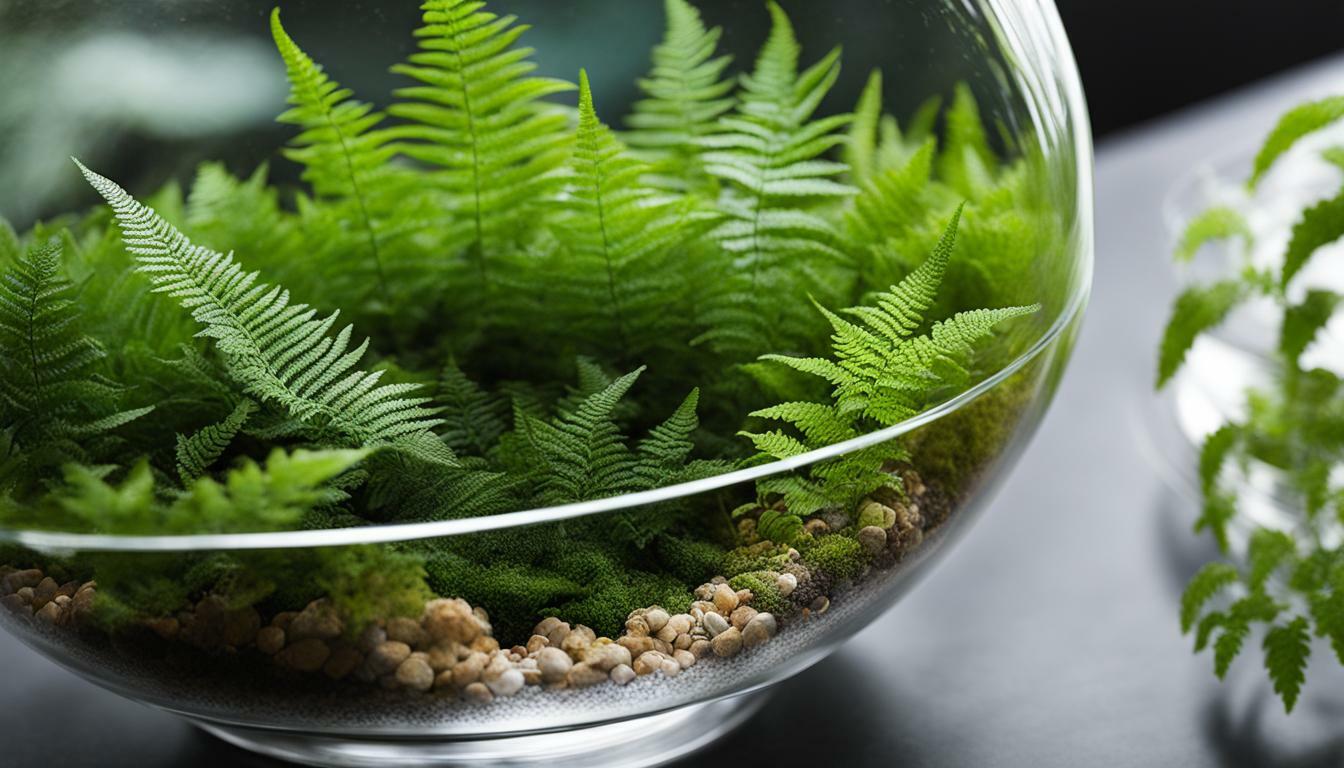Terrarium ferns are a popular choice for indoor gardening as they bring beauty, texture, and a calming touch to any space. These plants are well-suited for terrariums due to their ability to thrive in moist and low-light environments. When choosing ferns for your terrarium, consider factors such as plant size, frond size, and planting type. Some small fern varieties that are great for terrariums include Miniature Ferns, Micro Ferns, and easily divided larger ferns. To propagate ferns, you can use methods such as division or spores. Proper care for terrarium ferns involves providing the right temperature, soil, and moisture conditions. Overall, terrarium ferns are a low-maintenance and versatile option for indoor gardening.
- Terrarium ferns are a popular choice for indoor gardening due to their beauty and calming effect.
- They thrive in moist and low-light environments, making them perfect for terrariums.
- When selecting ferns for your terrarium, consider factors like size and planting type.
- Miniature Ferns, Micro Ferns, and easily divided larger ferns are great options for small terrariums.
- Propagation methods for ferns include division and spores.
Benefits of Terrarium Plants
Terrarium plants offer a range of benefits, making them an ideal choice for indoor gardening enthusiasts. These plants not only bring beauty and greenery to your living space but also provide several advantages that contribute to a healthy and inviting atmosphere.
One of the key benefits of terrarium plants is their ability to thrive in low-light conditions. This makes them perfect for areas in your home that don’t receive direct sunlight, such as offices or rooms with limited windows. With the right selection of low light terrarium plants, you can create a lush, green environment even in spaces that lack natural light.
Another advantage of terrarium plants is their easy care nature. Many varieties require minimal maintenance, making them perfect for busy individuals or those new to indoor gardening. These easy care terrarium plants are resilient and can tolerate some neglect, making them forgiving options for beginners.
Additionally, terrarium plants are known for their air purifying properties. They help to improve the air quality in your home by absorbing toxins and releasing oxygen. This can have a positive impact on your health and well-being, creating a fresh and clean environment.
“Terrarium plants offer a range of benefits, making them an ideal choice for indoor gardening enthusiasts.”
To take advantage of these benefits, consider incorporating the best terrarium plants into your indoor gardening projects. Whether you’re looking to add a touch of green to your workspace or create a stunning terrarium centerpiece, these plants provide an excellent solution.
| Best Terrarium Plants | Light Requirements | Care Difficulty | Air Purifying Abilities |
|---|---|---|---|
| Ferns | Low to moderate light | Easy | Effective |
| Succulents | Bright, indirect light | Low | Effective |
| Spider Plants | Bright, indirect light | Easy | Highly effective |
These are just a few examples of the many terrarium plant options available. Choose the plants that best suit your preferences, the lighting conditions in your home, and your level of gardening experience. With the right selection, you can enjoy the beauty, ease, and air-purifying benefits of terrarium plants.
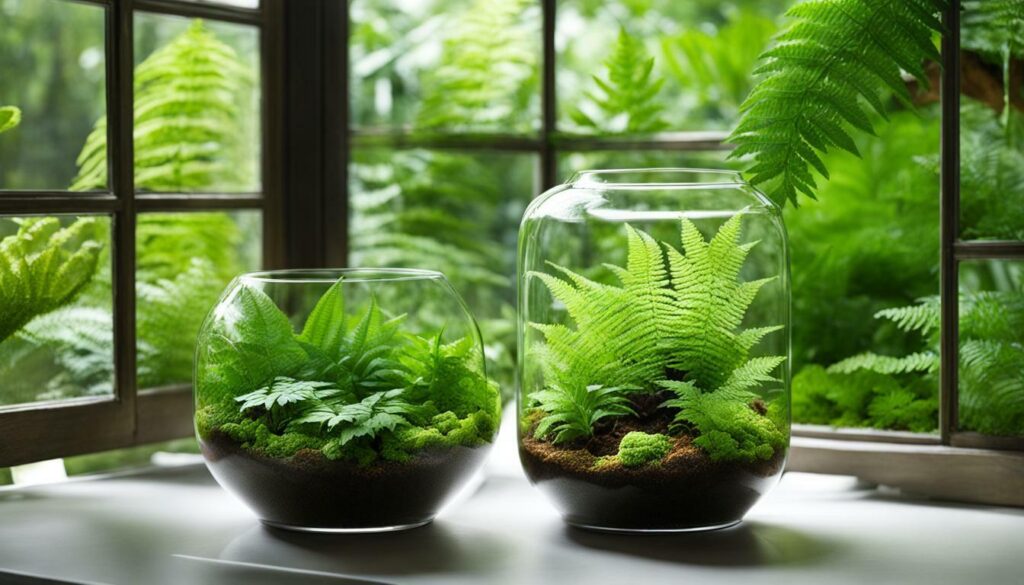
Remember to follow appropriate care instructions for each plant and provide them with the necessary conditions for their optimal growth. By incorporating terrarium plants into your indoor gardening projects, you can create a stunning and healthy environment that brings joy and tranquility to your home or office.
Choosing Ferns for Your Terrarium
Selecting the right ferns for your terrarium is crucial for creating a thriving indoor garden. These lush green plants add a touch of natural beauty and freshness to any space. When it comes to choosing ferns for your terrarium, there are a few factors to consider to ensure their success. One important consideration is the size of the ferns. Small terrarium plants are ideal for creating a balanced and visually appealing arrangement within the limited space of a terrarium.
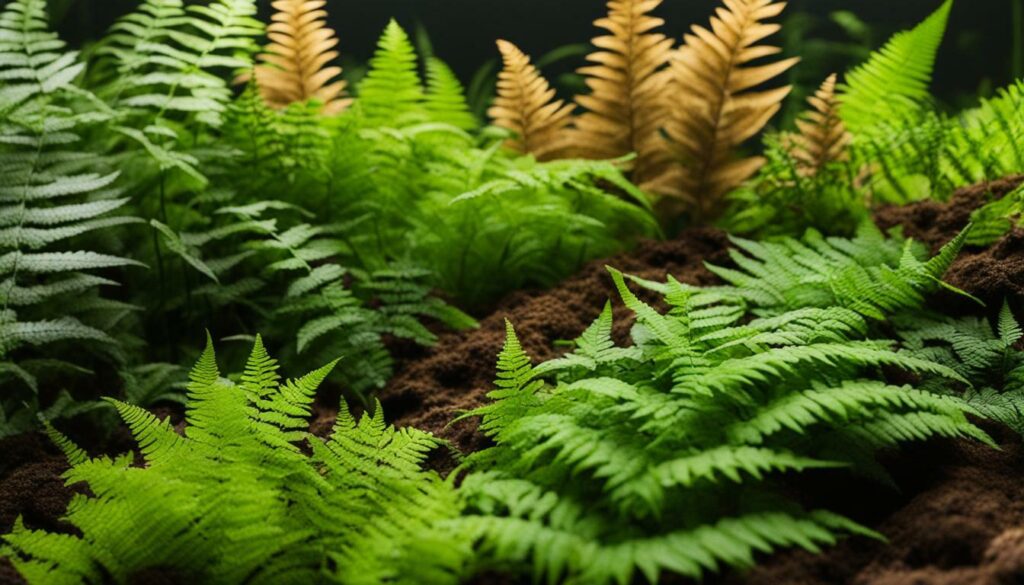
For beginners, it is recommended to choose terrarium plants that are relatively easy to care for. Look for fern varieties that are known for their resilience and ability to thrive in low-light conditions. These plants can tolerate the typically lower light levels found in terrarium environments. Additionally, terrarium plants for sale are often specifically selected for their suitability in enclosed spaces with limited airflow.
“The right choice of ferns can make all the difference in the success of your terrarium.”
Table 1: Ferns Suitable for Terrariums
| Fern Variety | Size | Light Requirements | Care Level |
|---|---|---|---|
| Miniature Ferns | Small | Low to medium | Easy |
| Micro Ferns | Very small | Low to medium | Easy |
| Easily Divided Larger Ferns | Varies | Low to medium | Moderate |
“Terrarium plants offer endless possibilities for creating unique and visually captivating displays.”
By carefully selecting the right ferns for your terrarium, you can create a stunning indoor garden that brings a piece of nature indoors. Whether you opt for small terrarium plants, prefer beginner-friendly varieties, or explore the range of ferns available for sale, there is a perfect option for every terrarium enthusiast. So go ahead, let your creativity bloom and enjoy the beauty and tranquility of a thriving terrarium garden.
Small Fern Varieties for Terrariums
If you’re looking to create a compact and visually appealing terrarium, consider incorporating small fern varieties. These delicate ferns not only add a touch of greenery to your enclosed garden but also bring a sense of enchantment to any space. They are ideal for terrariums due to their ability to thrive in the moist and low-light conditions typically found in these enclosed environments.
When it comes to small fern varieties for terrariums, there are several options to choose from. One popular choice is Miniature Ferns, which feature tiny fronds and a compact growth habit. These ferns are perfect for creating a lush and intricate terrarium landscape. Another option is Micro Ferns, which are even smaller in size. These pint-sized ferns add a delicate and intricate touch to your terrarium, creating a stunning miniature forest. Additionally, easily divided larger ferns can be a great choice for filling up larger terrariums or creating a focal point in your enclosed garden.
“Small fern varieties bring a sense of enchantment and create a stunning miniature forest in your terrarium.”
To create a beautiful terrarium with small ferns, you can play around with different arrangements and combinations. For instance, you can mix different varieties of small ferns together to create a diverse and visually appealing display. You could also pair small ferns with other terrarium plants to create a more dynamic and layered look. Regardless of the specific small fern varieties you choose, incorporating them into your terrarium will undoubtedly enhance its overall beauty and create a captivating indoor garden.
| Fern Variety | Size | Characteristics |
|---|---|---|
| Miniature Ferns | Small | Tiny fronds, compact growth habit |
| Micro Ferns | Very small | Pint-sized fronds, delicate and intricate |
| Easily Divided Larger Ferns | Varies | Large fronds, can be divided to create more plants |
With their beauty and adaptability, small fern varieties are the perfect choice for adding charm and elegance to your terrarium. Whether you’re a beginner or an experienced terrarium enthusiast, these ferns are easy to care for and will thrive in the enclosed environment. So go ahead and create your own miniature forest by incorporating small ferns into your terrarium. It’s time to bring a touch of nature indoors and create a captivating green oasis.
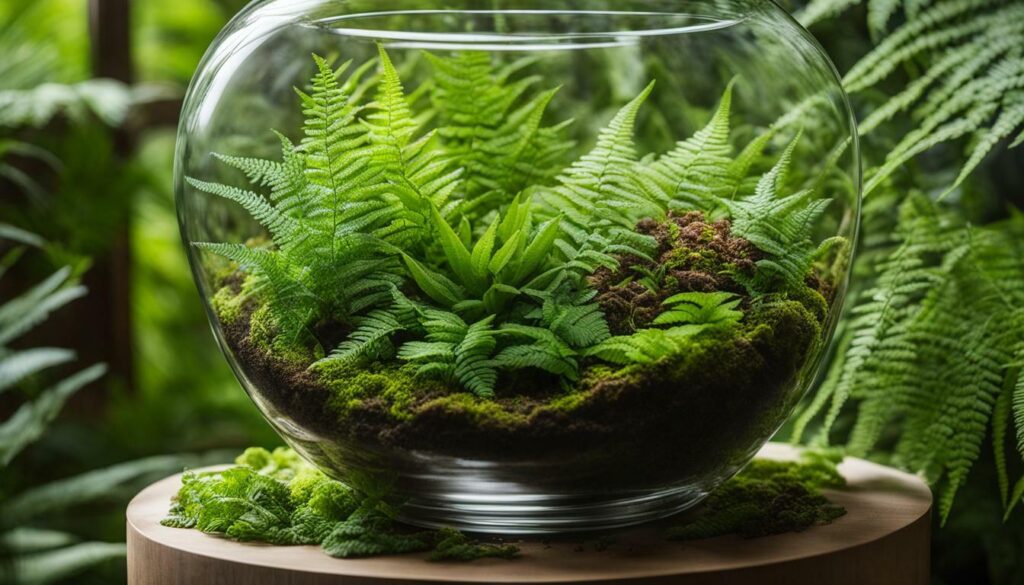
Propagating Ferns for Your Terrarium
Propagating ferns can be a rewarding process that allows you to expand your collection of terrarium plants. Whether you want to duplicate your favorite fern or experiment with different varieties, there are several methods you can use, including division and spores.
Division: One common way to propagate ferns is through division. This method involves carefully separating the root ball of an existing fern into multiple sections, each with its own set of fronds and roots. To do this, gently remove the fern from its pot and carefully tease apart the root mass. Ensure that each division has enough roots and fronds to sustain itself. Transplant the new divisions into separate pots filled with a well-draining soil mix, and provide them with the same care as mature ferns.
Spores: Another propagation method for ferns is using spores. Ferns produce spores, which are small reproductive structures found on the underside of their fronds. To collect spores, find a mature frond with ripe spores (they will look like fine dust). Place a piece of paper or a glass slide beneath the frond and gently shake it to release the spores onto the surface. Transfer the spores to a container filled with a moist growing medium, such as a mixture of peat moss and perlite. Keep the container covered to maintain high humidity, and provide indirect light. With time and proper care, the spores will germinate and grow into new ferns.
By propagating ferns, you can easily fill your terrarium with an abundance of lush greenery. Whether you choose to divide existing ferns or experiment with spores, the process of propagation allows you to enjoy the beauty and benefits of these plants while expanding your indoor gardening collection.
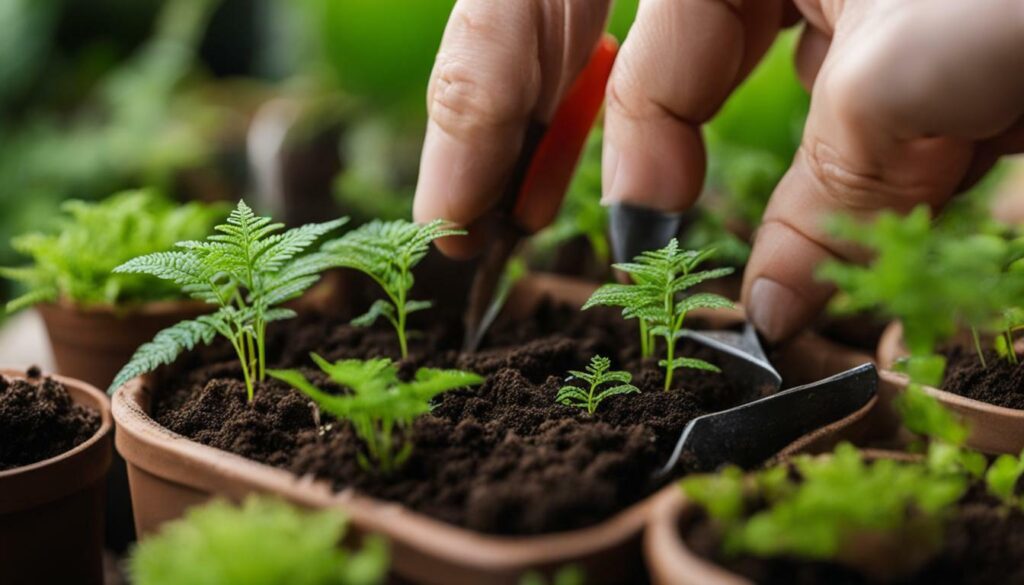
| Propagation Method | Advantages | Disadvantages |
|---|---|---|
| Division |
|
|
| Spores |
|
|
Care Tips for Terrarium Ferns
Providing the right care is essential for ensuring the health and longevity of your terrarium ferns. These delicate plants require specific temperature, soil, and moisture conditions to thrive in an indoor environment.
Temperature: Terrarium ferns prefer moderate temperatures between 60-75°F (15-24°C). Avoid exposing them to extreme temperature fluctuations or drafts, as they can cause stress and damage the plants. Keep your terrarium in a room with a stable temperature to provide a consistent and comfortable environment for your ferns.
Soil: Choose a well-draining soil mix specifically formulated for terrarium plants. This type of soil allows excess water to flow through while retaining enough moisture for ferns to thrive. Avoid using regular potting soil, as it can become compacted and lead to root rot. A mix of peat moss, perlite, and a small amount of sand creates an ideal growing medium for your terrarium ferns.
Moisture Conditions: Terrarium ferns require consistent moisture levels to replicate their natural habitat. Use a spray bottle to mist the leaves and soil regularly, ensuring they don’t dry out completely. Maintain a high humidity level by placing a small dish of water in the terrarium or using a humidity tray. Monitor the moisture levels to prevent overwatering, as excessive moisture can lead to fungal diseases and root rot.
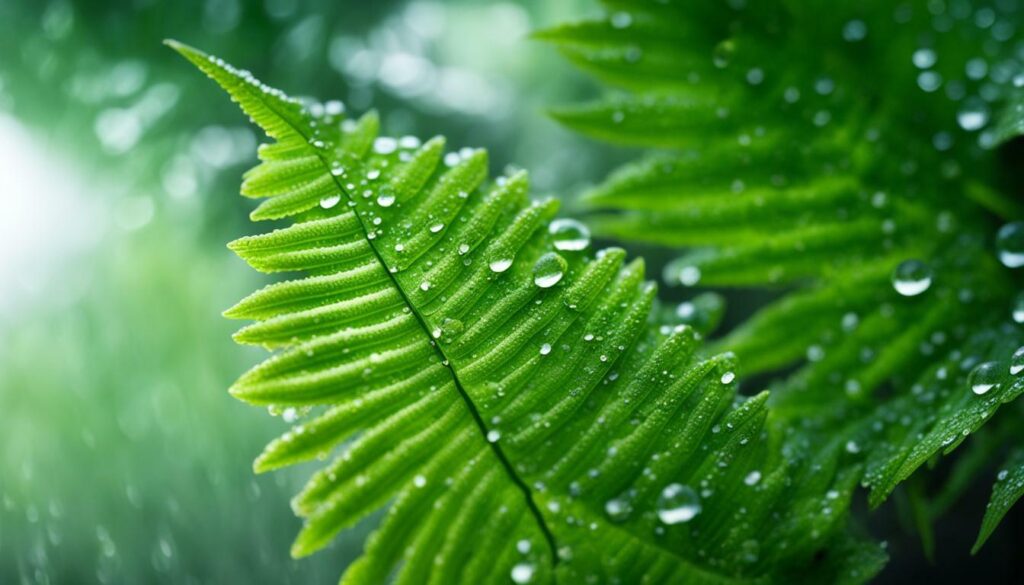
Keep in mind that different fern species may have specific care requirements, so it’s always a good idea to research the specific needs of the ferns you choose for your terrarium. By providing the right care, you can create a thriving terrarium filled with lush and healthy ferns, enhancing the beauty of your indoor space.
Maintaining Temperature for Terrarium Ferns
Proper temperature maintenance is crucial for the well-being of your terrarium ferns. These delicate plants thrive in specific temperature ranges that mimic their natural habitat. It’s essential to provide the right conditions to ensure their growth and longevity.
The ideal temperature range for most terrarium ferns is between 65°F and 75°F (18°C and 24°C). This moderate temperature allows them to flourish without experiencing stress. Keeping the temperature within this range will help your ferns maintain their vibrant green foliage and prevent them from becoming too dormant or overheated.
It’s important to note that different fern species may have specific temperature requirements. Some ferns prefer slightly cooler temperatures, while others can tolerate slightly higher temperatures. Research the specific needs of the fern species you have in your terrarium to ensure optimal conditions.
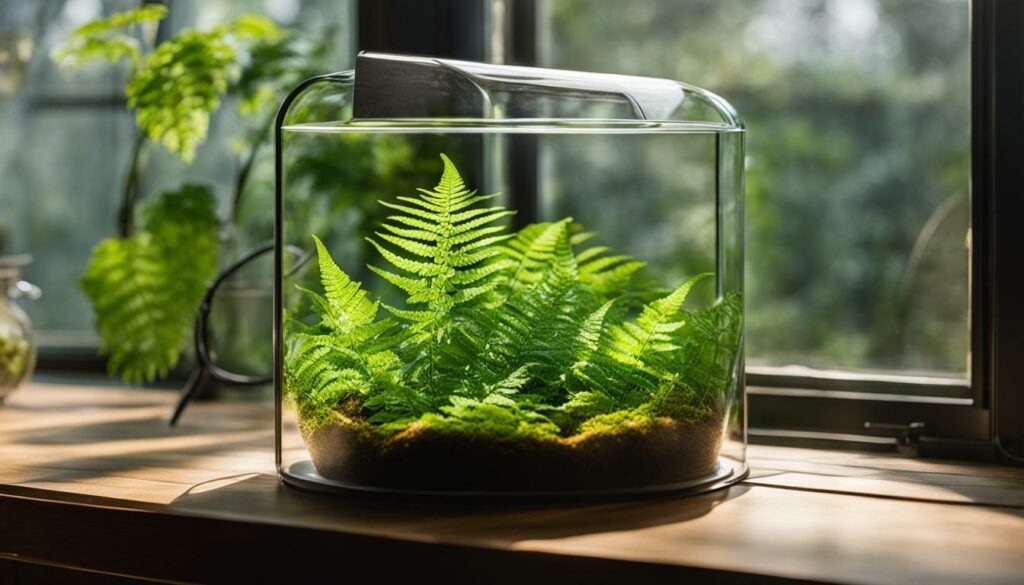
In addition to maintaining the right temperature range, it’s helpful to monitor the temperature fluctuations in your home. Avoid placing your terrarium in areas exposed to direct sunlight or cold drafts, as these extreme temperature changes can stress your ferns. Instead, choose a location with consistent room temperature, away from heating vents or air conditioning units.
Remember, maintaining a stable temperature environment is crucial for the health and growth of your terrarium ferns. By providing the right conditions, you’ll create an optimal environment for these beautiful plants to thrive.
Soil Preferences for Terrarium Ferns
Choosing the right soil is key to providing a suitable growing environment for your terrarium ferns. These plants have specific needs when it comes to soil type and drainage, which directly impact their overall health and growth. Understanding their soil preferences is essential for successfully cultivating terrarium ferns.
Terrarium ferns thrive in well-draining soil that allows excess water to flow freely, preventing waterlogging and root rot. A mixture of peat moss, perlite, and sphagnum moss creates an ideal soil composition that provides excellent drainage while retaining moisture. This combination ensures that the ferns’ delicate roots are neither oversaturated nor deprived of essential moisture.
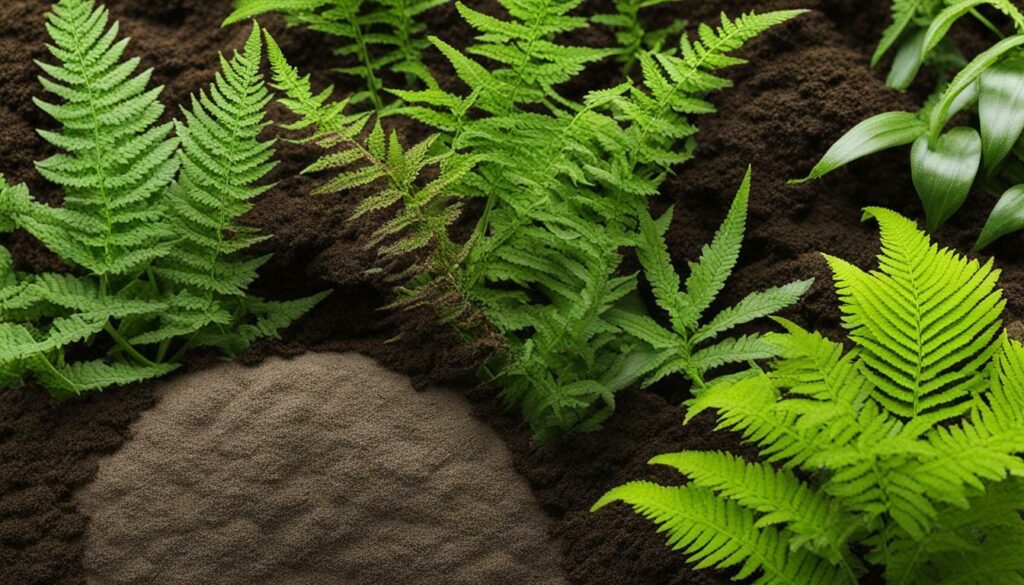
Another important consideration is the acidity level of the soil. Most ferns prefer slightly acidic soil with a pH range of 5.5 to 6.5. Maintain the proper pH by regularly testing the soil using a pH testing kit, and adjust it if necessary by adding organic matter like peat moss or burlap. This will create an optimal environment for your terrarium ferns to thrive.
When potting your ferns, choose a container with adequate drainage holes to prevent water from pooling at the bottom. This will help maintain the right moisture level for your plants and avoid the risk of root rot. Additionally, placing a layer of small stones or gravel at the bottom of the pot can enhance drainage and prevent the soil from becoming waterlogged.
Summary:
- Terrarium ferns require well-draining soil to prevent root rot.
- A mixture of peat moss, perlite, and sphagnum moss creates an ideal soil composition with good drainage and moisture retention.
- Maintain slightly acidic soil with a pH range of 5.5 to 6.5 for optimal growth.
- Use containers with adequate drainage holes and add a layer of stones or gravel to enhance drainage.
| Soil Preferences for Terrarium Ferns | Summary |
|---|---|
| Terrarium ferns require well-draining soil | Prevents root rot |
| Mixture of peat moss, perlite, and sphagnum moss for ideal soil composition | Good drainage and moisture retention |
| Maintain pH range of 5.5 to 6.5 for slightly acidic soil | Optimal growth conditions |
| Use containers with drainage holes and add stones or gravel | Enhances drainage and prevents waterlogging |
Moisture Requirements for Terrarium Ferns
Proper moisture management is vital for the overall health and vigor of your terrarium ferns. These plants naturally thrive in moist environments, and maintaining the right moisture level is key to their successful growth. Here are some essential tips to help you effectively manage the moisture requirements of your terrarium ferns.
1. Monitor the moisture: Ferns in terrariums prefer consistently moist soil. Use a moisture meter or your finger to test the soil’s moisture level regularly. Aim for soil that feels slightly damp to the touch, but not waterlogged. Overwatering can lead to root rot and other issues, so it’s important to strike the right balance.
2. Misting: Terrarium ferns benefit from periodic misting to increase humidity levels. Fill a spray bottle with filtered or distilled water and mist the foliage once or twice a week. This mimics the natural conditions ferns thrive in and helps prevent their delicate fronds from drying out.
3. Humidity: Ferns thrive in environments with high humidity levels. To maintain adequate humidity in your terrarium, you can place a humidity tray filled with water beneath the plants. As the water evaporates, it increases the ambient moisture around the ferns. Alternatively, consider using a small humidifier to create the ideal humidity level for your terrarium ferns.
| Moisture Tips for Terrarium Ferns |
|---|
| Monitor the moisture regularly |
| Mist the foliage once or twice a week |
| Use a humidity tray or small humidifier |
By following these moisture management techniques, you can provide optimal growing conditions for your terrarium ferns. Remember to consider the specific moisture needs of each fern species and adjust your care accordingly. With the right moisture balance, your terrarium ferns will flourish and bring lush greenery into your indoor space.
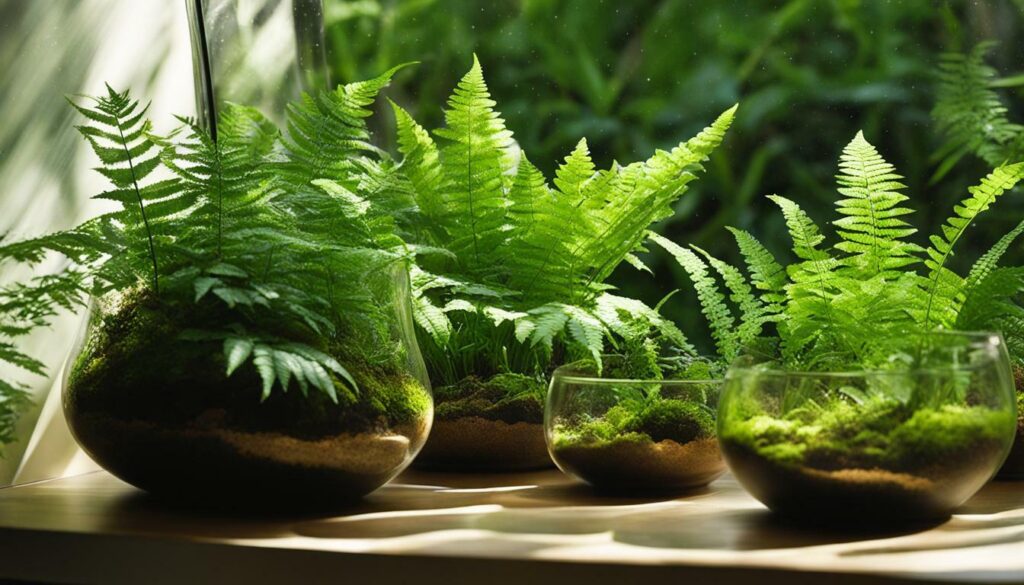
Terrarium ferns are an excellent choice for those seeking low-maintenance and adaptable indoor plants. With their lush green foliage and delicate fronds, they bring a touch of nature into any space. These plants are especially well-suited for terrariums, as they thrive in moist and low-light environments, making them perfect for indoor gardening enthusiasts of all levels.
When selecting ferns for your terrarium, there are a few factors to consider. Plant size is an important consideration, as you want to choose varieties that will fit well within the confines of your terrarium. Additionally, frond size and planting type should be taken into account. Some ferns, like the Miniature Ferns and Micro Ferns, are naturally smaller in size and can easily adapt to the limited space of a terrarium. On the other hand, there are larger ferns that can be easily divided, allowing you to create multiple plants and fill your terrarium with lush greenery.
To propagate ferns for your terrarium, you can use different methods such as division or spores. Division involves separating the plant into multiple sections, each with its own root system, while spores are tiny reproductive cells that can be collected and used to grow new ferns. Both techniques can be successful, but it’s important to follow proper guidelines and provide the right conditions for the newly propagated ferns to thrive.
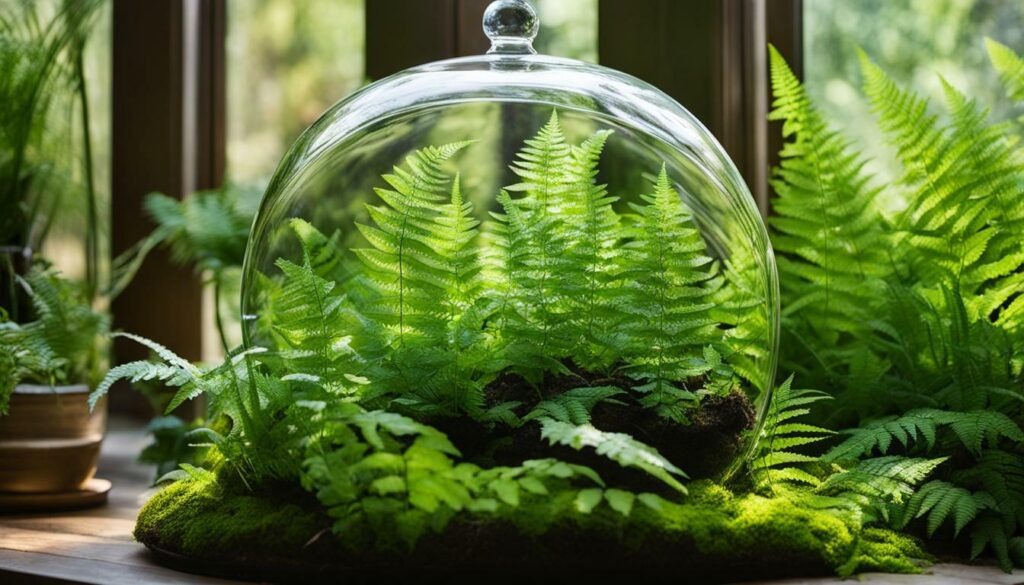
Proper care is essential for the health and longevity of your terrarium ferns. These plants prefer temperatures between 60-75°F (15-24°C), making them a great choice for indoor environments. It’s important to provide them with well-draining soil, as they don’t tolerate overly wet conditions. Maintaining the right moisture level is crucial, and regular misting can help create the humid environment that ferns thrive in. By following these care tips, you can ensure that your terrarium ferns remain vibrant and vibrant for years to come.
Creating a Beautiful Indoor Terrarium with Ferns
With careful planning and creativity, you can design a stunning indoor terrarium using beautiful ferns. These versatile plants add a touch of natural beauty to any space and are especially well-suited for terrariums due to their ability to thrive in moist and low-light environments. Whether you’re a beginner or an experienced gardener, creating an indoor terrarium with ferns is a rewarding and enjoyable project.
When designing your terrarium, consider the size and shape of the container. Choose a glass vessel that allows for proper airflow and provides enough space for your ferns to grow. It’s important to select ferns that complement each other in terms of size, frond shape, and planting type. This will help create a harmonious and visually appealing display.
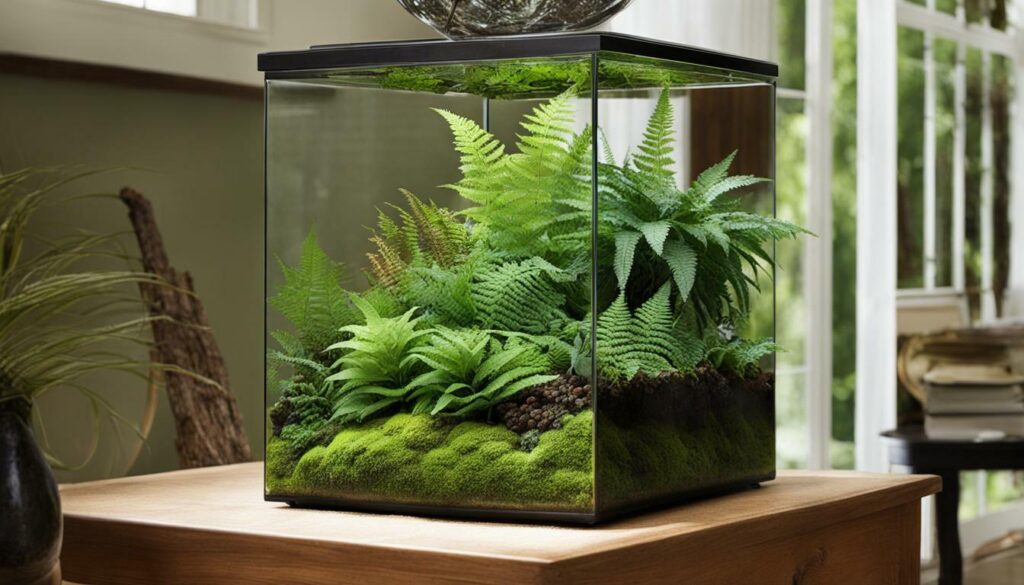
For a more dynamic terrarium design, you can incorporate different layers. Start by adding a layer of well-draining soil, followed by a layer of activated charcoal to filter water and reduce odor. Then, arrange your ferns in a way that creates depth and variety. Consider using different heights, textures, and colors to create visual interest. You can also add decorative elements such as rocks, moss, or figurines to enhance the overall aesthetics of your terrarium.
Remember to provide the right care for your terrarium ferns. Keep the terrarium in an area with indirect sunlight and maintain a consistent temperature range of 60-75°F (15-24°C). Water the ferns sparingly as they prefer slightly moist conditions but can be sensitive to overwatering. Regularly mist the leaves to increase humidity and prevent the soil from drying out completely. With proper care, your terrarium ferns will flourish and provide you with a beautiful indoor garden to enjoy.
Conclusion
Terrarium ferns offer a wonderful opportunity to bring the beauty of nature into your home, providing a calming and visually captivating indoor garden. These plants have gained popularity in the world of indoor gardening due to their ability to thrive in moist and low-light environments, making them a perfect choice for terrariums.
When selecting ferns for your terrarium, it’s important to consider factors such as plant size, frond size, and planting type. Small fern varieties like Miniature Ferns, Micro Ferns, and easily divided larger ferns are particularly well-suited for terrariums, as they can fit and thrive within the limited space.
To propagate ferns for your terrarium, you have a couple of options. You can either use the division method, where you separate a portion of an existing fern and plant it in a new container, or you can utilize spores, which are the reproductive cells of ferns.
Caring for terrarium ferns involves providing the right temperature, soil, and moisture conditions. These plants thrive in a temperature range that is suitable for indoor environments, and they prefer a well-draining soil mix to ensure proper moisture absorption and avoid waterlogged roots. Additionally, maintaining adequate humidity and misting the fronds occasionally can help create the ideal environment for terrarium ferns to flourish.
Overall, terrarium ferns are a great choice for those seeking low-maintenance and versatile indoor plants. With their lush foliage and unique textures, they bring a touch of nature into your home while adding a sense of tranquility. So, whether you’re a beginner or a seasoned indoor gardener, terrarium ferns are sure to enhance the beauty of your space and provide you with a serene and captivating indoor garden.
Can Ground Ferns and Bromeliads Thrive in the Same Indoor Terrarium Environment?
Yes, ground ferns and bromeliads for indoor gardens can thrive in the same terrarium environment. Both plants enjoy similar levels of humidity and indirect light. The ferns provide a lush, green backdrop to the unique, colorful foliage of the bromeliads, creating a beautiful and harmonious indoor garden display.
FAQ
What makes terrarium ferns a popular choice for indoor gardening?
Terrarium ferns bring beauty, texture, and a calming touch to any space. They thrive in moist and low-light environments, making them well-suited for terrariums.
How do I choose ferns for my terrarium?
When choosing ferns for your terrarium, consider factors such as plant size, frond size, and planting type. Some small fern varieties that are great for terrariums include Miniature Ferns, Micro Ferns, and easily divided larger ferns.
How can I propagate ferns for my terrarium?
Ferns can be propagated through methods such as division or spores. Division involves separating the fern into smaller plants, while spores can be collected and grown into new ferns.
What care do terrarium ferns require?
Proper care for terrarium ferns involves providing the right temperature, soil, and moisture conditions. Ferns prefer a moderate temperature range, well-draining soil, and consistent moisture levels.
What temperature should I maintain for terrarium ferns?
Terrarium ferns have specific temperature requirements, but generally, they thrive in temperatures between 60-75°F (15-24°C). It’s important to keep them away from drafts and extreme temperature fluctuations.
What type of soil do terrarium ferns prefer?
Terrarium ferns prefer a well-draining soil mix that retains some moisture. A mixture of peat moss, perlite, and vermiculite or orchid bark can provide the ideal soil conditions for ferns.
How often should I water my terrarium ferns?
Terrarium ferns need consistent moisture levels, but it’s important not to overwater them. Water them when the top inch of soil feels dry, and avoid allowing the soil to become waterlogged.
Are terrarium ferns low-maintenance indoor plants?
Yes, terrarium ferns are considered low-maintenance indoor plants. They require less direct light compared to other plants and can thrive in the relatively stable conditions provided by a terrarium.
How can I create a beautiful indoor terrarium with ferns?
To create a beautiful indoor terrarium with ferns, consider the overall design and arrangement. Play with different fern varieties, heights, and textures to create visual interest. You can also add decorative elements, such as small figurines or rocks, to enhance the terrarium’s aesthetic appeal.

